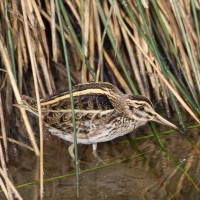Description
The area around Horn kyrka is a quite good site for geese with hundreds of Gâscă de semănătură, Gâscă de vară, and Gâscă canadiană found most years. Often with lesser amounts of Gârliță mare, Tundra Bean Goose, Gâscă cu cioc scurt, and Gâscă călugăriță interspersed. Gâscă neagră has been seen. Most geese are found by Rien (marked with a star on the map) in late Febuary and March.
During the spring Riens water overflow and large amounts of open water form. When this happens large amounts of Rață mare (at most 200), and Rață mică (at most 150) rest in the area. Among these ducks you can observe smaller amounts of Rață fluierătoare, Rață pestriță, Rață fluierătoare, Rață sulițar (uncommon), Rață lingurar (uncommon), and Rață cârâitoare (rare). Sometimes also some diving ducks. But since water levels vary each spring the amount and variation of ducks at Rien vary accordingly. The wetland at Hornebergs holds permanent water, and usually some dabbling ducks, but not in the same amount. Horn Marsh along with its ponds is also quite good for small amounts of different dabbling ducks.
Diving ducks are most usually found in Åsunden with Ferestraș mare, Rață moțată, Rață sunătoare being common, while Ferestraș moțat and Ferestraș mic are uncommon. At Trossbonäs rare diving ducks like Rață neagră , and Rață catifelată can be found with luck in April. Even Eider and Rață cu cap negru have been seen there.
In spring if Rien has water in late April waders rest there. Fluierar de mlaștină, Fluierar de zăvoi (at most 23), Nagâț, and Becațină comună (at most 100). On the fields Ploier auriu, at Åsunden Fluierar de munte sing, and in the forests Sitar de pădure can be found. During heavy autumn rain Rien can gain enough water for waders such as Fluierar cu picioare verzi, Bătăuș, Fugaci de țărm, Culic mare, Prundăraș gulerat mare, and Fugaci roșcat. The fields around Bränna and Västa eneby are pretty good areas for Becațină mică in November.
Among predatory birds Vânturel roșu, Șorecar comun, Viespar, Șorecar încălțat, Codalb, Uliu păsărar, Uliu porumbar, Uligan pescar, Șoimul rândunelelor and Erete vânăt are all common. Acvilă de munte, Șoim de iarnă, Șoim călător, and Gaie neagră are all rare but seen some years. The best places for them are Bränna, Rien, and Åshorva.
Large amounts of passerine birds move along the fields around Horn, therefore large amounts of Cânepar, Fâsă de luncă, Codobatură galbenă and other common meadows birds are found along with other rare passerine birds like Gușă vânătă, Mierlă gulerată, Presură de tundră (very rare), Pasărea omătului, and Inăriță cu cioc galben. The best places for these are Bränna and Rien.
The wetland around Rien and Hornsberg have large amounts of reed and trees which make them excellent places for nightactive birds. All the common bird are found some years with Cristel de câmp, Prepeliță, Lăcar nordic, Grelușel de zăvoi, Cresteț pestriț, and Grelușel pătat. Even Cresteț cenușiu has been found.
Details
Access
Horn is located on the southern shores of lake Åsunden. No good parking spots can be found for most of these places but it is often possible to park alongside the road. The area is best explored with bike or car and perhaps not best suited to tourists because there are few facilities for visitors.





